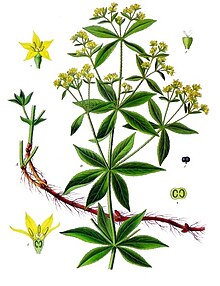

"Rubia tinctorum, the common madder or dyer's madder, is a plant species in the genus Rubia. It has been used since ancient times as a vegetable red dye for leather, wool, cotton and silk. For dye production, the roots are harvested in the first year. The outer brown layer gives the common variety of the dye, the lower yellow layer the refined variety. The dye is fixed to the cloth with help of a mordant, most commonly alum. Madder can be fermented for dyeing as well (Fleurs de garance). In France, the remains were used to produce a spirit as well. The roots contain the acid ruberthyrin. By drying, fermenting or a treatment with acids, this is changed to sugar, alizarin and purpurin, which were first isolated by the French chemist Pierre Jean Robiquet in 1826. Purpurin is normally not coloured, but is red when dissolved in alkaline solutions. Mixed with clay and treated with alum and ammonia, it gives a brilliant red colourant (madder lake). The pulverised roots can be dissolved in sulfuric acid, which leaves a dye called garance (the French name for madder) after drying. Another method of increasing the yield consisted of dissolving the roots in sulfuric acid after they had been used for dyeing. This produces a dye called garanceux. By treating the pulverized roots with alcohol, colorin was produced. It contained 40–50 times the amount of alizarin of the roots. The chemical name for the pigment is alizarin, of the anthraquinone-group, and was used to make the alizarine ink in 1855 by the Professor Leonhardi of Dresden, Germany. In 1869, the German chemists Graebe and Liebermann synthesised artificial alizarin, which was produced industrially from 1871 onwards, which effectively put an end to the cultivation of madder. In the 20th century, madder was only grown in some areas of France."
WikipediaThat last statement isn't entirely true ...
I am going to plant a Dyer's Garden in the spring. The center tray shows the madder plants I started from seed (that's Japanese Indigo on the left).
Enjoy!
No comments:
Post a Comment